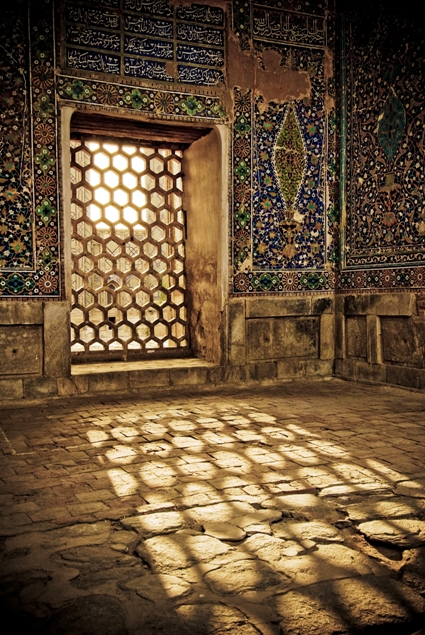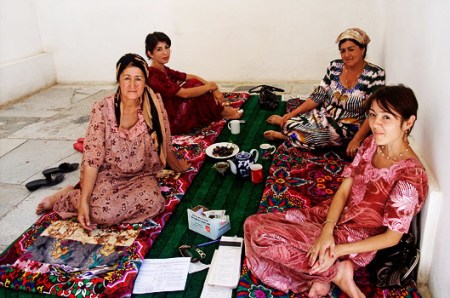Throughout its history, Uzbekistan has been one of the world’s great commercial and cultural crossroads. Across its length ran the Northern Silk Road, the lifeline that the caravans and traders travelled exchanging gems, spices, and other rare items from the orient to the West and back again.
Evidence of episodic trade in semi-precious gems (jade and lapis lazuli) between China and Afghanistan along the Silk Road dates back almost 4000 years, with evidence of trading posts across Uzbekistan can be found from the first millennium BCE. During the reign of Roman Emperor Augustus, diplomatic and trade contact between Rome and China and India was common and it was Rome that linked the northern land routes with the southern maritime routes, drawing North Africa and the Levant states into the whole of the Silk Road web.

Timur (Tamerlane) wanted Samarkand to be as beautiful and majestic a place as the world’s artists and academicians could make it. He wanted it to be fit for a king and after each of his successful campaigns he spared the lives of the greatest thinkers and artisans he could find and sent them back to Samarkand. During his long reign, lasting most of the fourteenth century, these established neighborhoods of Persians, Syrians and Armenians and Turks within the city that complemented the communities of Greeks, Egyptians and Chinese already living there.
Features of all of these cultures can be found in Uzbek cuisine, but by far the biggest dog on the influence block is Persia. From the Uzbek use of sour cherries to the use of grape leaves or the abundant presence of dried fruits and nuts in stews, many of the elements of modern Uzbek cuisine can be traced back to Persian cuisine.
Some of the strongest examples of Persian-influenced Uzbek cooking offered in the next volume of The Silk Road Gourmet – Volume 2 will be Lamb Stew with Chestnuts and Pomegranates, Meatballs with Sweet and Sour Cherries and of course, Yogurt with Garlic and Mint. Turkic influence is seen particularly in the Savory Stuffed Onions recipe and the Onion and Pomegranate Salad. An Arab-Levant influence can be found in the Yogurt Noodles and a modern Korean influence in Sesame-Soy Carrots and several other vegetable recipes. So many influences in one country – history is on every plate.
I’ll leave you with a sample recipe of Savory Stuffed Onions to inspire dreams about the Silk Road. This is a wonderful dish that is sweet and spicy at the same time. it can really be served as one of several meat dishes on an omnivore table or by substituting more precooked rice for the lamb and vegetable broth for the beef broth, it would work on a vegetarian table as well. I use sweet Mayan onions when available to offset the full flavor of the meat stuffing, but Vidalia or any other type of onion can be used if desired. Again, stuffed vegetables like this are a Turkic legacy that are eaten throughout Central Asia with several virtually identical dishes are found in traditional Turkish cooking.
Savory Stuffed Onions
Ingredients
2 large, sweet Mayan onions
1 rib celery, chopped
3/4 cup carrots, quartered
2 teaspoons garlic, peeled and chopped
1 teaspoons salt
1/2 teaspoons pepper
11/2 teaspoons ground cumin
1 teaspoon dried fenugreek leaves
1 teaspoon dried marigold petals
1 teaspoon dried savory
2 hot, dried, red chili peppers
1/4 pound ground lamb
1 small egg, beaten
2 tablespoons cooked rice
3 tablespoons peanut or light sesame oil
3 tablespoons tomato paste
1 teaspoon lemon juice
1/2 cup chickpeas, cooked
1 cup beef or vegetable broth (or more if needed)
Directions
Peel, rinse and hollow out the onions, setting the insides aside and leaving a firm bowl for stuffing.
Directions
In a food processor, combine the celery, carrot, garlic, salt, pepper, 1 teaspoon of the cumin, fenugreek, marigold, savory, and chili peppers with the ground lamb. Grind lightly to mix, leaving vegetables with form.
Blend in the egg, 1 tablespoon of the tomato paste and rice into the meat mix, mixing only briefly. Stuff the onion shells with the mixture.
Heat oil and when hot, add the onion pulp and sauté. When starting to become translucent, add the remaining tomato paste, the rest of the cumin, lemon juice, chickpeas and meat broth, stir. Salt and pepper the tomato sauce to taste.
Place the stuffed onion shells in the pot and cover to cook. Cooking time about 45 minutes, but check every 10-15 minutes and stir, ladling some sauce over the top of the onions. If sauce becomes too thick, add more beef or vegetable broth to dilute.
(Words by Laura Kelley. Photo of Women Drinking Tea by Alexander Metelitsa)

